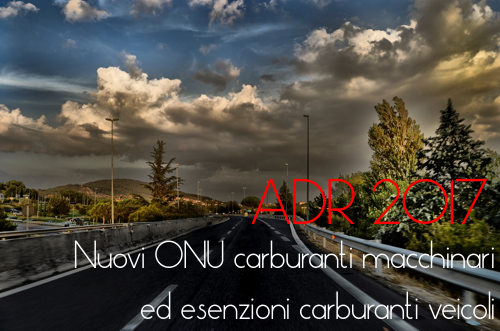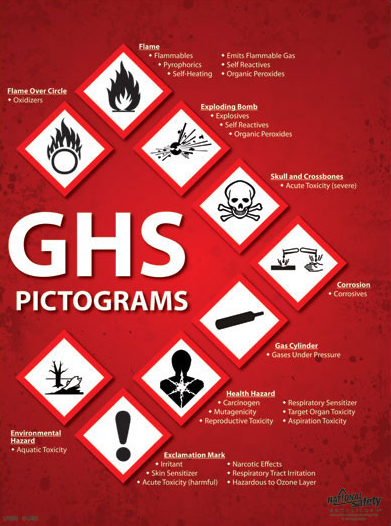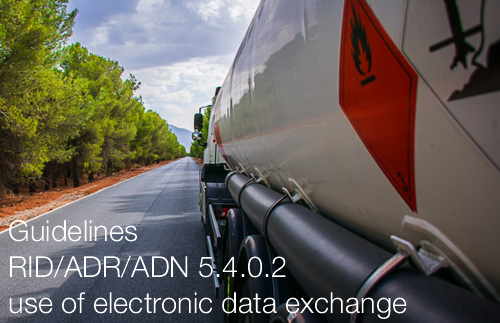Decreto 6 maggio 2025
ID 24025 | 26.05.2025
Decreto 6 maggio 2025 - Modifica del decreto 6 ottobre 2006, che regolamenta le modalita' di erogazione dei corsi per la formazione professionale dei conducen...

Inseriti nuovi ONU per motori di macchinari a combustione liquida e gassosa, introdotto nuovo capitolo esenzioni per i carburanti liquidi e gassosi dei veicoli LNG//CNG/LPG, ecc
Con l'ADR 2017 inserite le nuove rubriche 3528, 3529, 3530, (Disposizione Speciale 363) che si applicano ai motori o macchine, alimentate da combustibili classificati come merci pericolose, sistemi a combustione interna, celle a combustibile (motori a combustione ad esempio: generatori, compressori, turbine, impianti di riscaldamento, ecc) , in quantità superiori a quelli specificati nella colonna (7a) della Tabella a del capitolo 3.2 escluse gli equipaggiamenti del veicolo assegnati al Numero UN 3166 di cui all Disposizione Speciale 666.
Nuovo capitolo di Esenzione 1,3.3.2, per i gas contenuti nei serbatoi di carburante o bombole di un veicolo che esegue un'operazione di trasporto e per la sua propulsione o per il funzionamento di uno dei suoi equipaggiamenti utilizzati o destinati ad essere utilizzati durante il trasporto (ad esempio impianti di refrigerazione ).
I gas possono essere trasportati in serbatoi fissi di carburante o bombole, direttamente collegati al motore del veicolo e/o attrezzature ausiliarie o recipienti a pressione trasportabili, conformi alle disposizioni di legge pertinenti.
| (1) | (2) | (3a) | (3b) | (5) | (6) | (7a) | (7b) |
| 3528 | ENGINE, INTERNAL COMBUSTION, FLAMMABLE LIQUID POWERED or ENGINE, FUEL CELL, FLAMMABLE LIQUID POWERED or MACHINERY, INTERNAL COMBUSTION, FLAMMABLE LIQUID POWERED or MACHINERY, FUEL CELL, FLAMMABLE LIQUID POWERED | 3 | - | 3 | 363 367 |
0 | E0 |
| 3529 | ENGINE, INTERNAL COMBUSTION, FLAMMABLE GAS POWERED or ENGINE, FUEL CELL, FLAMMABLE GAS POWERED or MACHINERY, INTERNAL COMBUSTION, FLAMMABLE GAS POWERED or MACHINERY, FUEL CELL, FLAMMABLE GAS POWERED | 2 | - | 2.1 | 363 367 |
0 | E0 |
| 3530 | ENGINE, INTERNAL COMBUSTION or MACHINERY, INTERNAL COMBUSTION | 9 | - | 9 | 363 367 |
0 | E0 |
Special Provision (SP) 363 / 367
SP 363 (new)
(a) This entry applies to engines or machinery, powered by fuels classified as dangerous goods via internal combustion systems or fuel cells (e.g. combustion engines, generators, compressors, turbines, heating units, etc.), in quantities above those specified in column (7a) of Table A of Chapter 3.2, except vehicle equipment assigned to UN No. 3166 referred to in SP 666.
| (1) | (2) | (3a) | (3b) | |||||
| 3166 | ENGINE, INTERNAL COMBUSTION OR VEHICLE, FLAMMABLE GAS POWERED OR VEHICLE, FLAMMABLE LIQUID POWERED OR ENGINE, FUEL CELL, FLAMMABLE GAS POWERED OR ENGINE, FUEL CELL, FLAMMABLE LIQUID POWERED OR VEHICLE, FUEL CELL, FLAMMABLE GAS POWERED OR VEHICLE, FUEL CELL, FLAMMABLE LIQUID POWERED | 9 | M1 | NOT SUBJECT TO ADR | ||||
NOTE: This entry does not apply to equipment referred to in 1.1.3.3.
(b) Engines or machinery which are empty of liquid or gaseous fuels and which do not contain other dangerous goods, are not subject to ADR.
NOTE 1:
An engine or machinery is considered to be empty of liquid fuel when the liquid fuel tank has been drained and the engine or machinery cannot be operated due to a lack of fuel. Engine or machinery components such as fuel lines, fuel filters and injectors do not need to be cleaned, drained or purged to be considered empty of liquid fuels. In addition, the liquid fuel tank does not need to be cleaned or purged.
NOTE 2:
An engine or machinery is considered to be empty of gaseous fuels when the gaseous fuel tanks are empty of liquid (for liquefied gases), the pressure in the tanks does not exceed 2 bar and the fuel shut-off or isolation valve is closed and secured.
(c) Engines and machinery containing fuels meeting the classification criteria of Class 3, shall be assigned to the entries UN No. 3528 ENGINE, INTERNAL COMBUSTION, FLAMMABLE LIQUID POWERED or UN No. 3528 ENGINE, FUEL CELL, FLAMMABLE LIQUID POWERED or UN No. 3528 MACHINERY, INTERNAL COMBUSTION, FLAMMABLE LIQUID POWERED or UN No. 3528 MACHINERY, FUEL CELL, FLAMMABLE LIQUID POWERED, as appropriate.
(d) Engines and machinery containing fuels meeting the classification criteria of flammable gases of Class 2, shall be assigned to the entries UN No. 3529 ENGINE, INTERNAL COMBUSTION, FLAMMABLE GAS POWERED or UN No. 3529 ENGINE, FUEL CELL, FLAMMABLE GAS POWERED or UN No. 3529 MACHINERY, INTERNAL COMBUSTION, FLAMMABLE GAS POWERED or UN No. 3529 MACHINERY, FUEL CELL, FLAMMABLE GAS POWERED, as appropriate.
Engines and machinery powered by both a flammable gas and a flammable liquid shall be assigned to the appropriate UN No. 3529 entry.
(e) Engines and machinery containing liquid fuels meeting the classification criteria of 2.2.9.1.10 for environmentally hazardous substances and not meeting the classification criteria of any other class shall be assigned to the entries UN No. 3530 ENGINE, INTERNAL COMBUSTION or UN No. 3530 MACHINERY, INTERNAL COMBUSTION, as appropriate.
(f) Engines or machinery may contain other dangerous goods than fuels (e.g. batteries, fire extinguishers, compressed gas accumulators or safety devices) required for their functioning or safe operation without being subject to any additional requirements for these other dangerous goods, unless otherwise specified in ADR. However, lithium batteries shall meet the requirements of 2.2.9.1.7, except as provided for in special provision 667.
(g) The engines or machinery are not subject to any other requirements of ADR if the following requirements are met:
(i) The engine or machinery, including the means of containment containing dangerous goods, shall be in compliance with the construction requirements specified by the competent authority of the country of manufacture2 ;
(ii) Any valves or openings (e.g. venting devices) shall be closed during carriage;
(iii) The engines or machinery shall be oriented to prevent inadvertent leakage of dangerous goods and secured by means capable of restraining the engines or machinery to prevent any movement during carriage which would change the orientation or cause them to be damaged;
(iv) for UN No. 3528 and UN No. 3530: Where the engine or machinery contains more than 60 l of liquid fuel and has a capacity of more than 450 l but not more than 3 000 l, it shall be labelled on two opposite sides in accordance with 5.2.2. Where the engine or machinery contains more than 60 l of liquid fuel and has a capacity of more than 3 000 l, it shall be placarded on two opposite sides. Placards shall correspond to the labels required in Column (5) of Table A of Chapter 3.2 and shall conform to the specifications given in 5.3.1.7. Placards shall be displayed on a background of contrasting colour, or shall have either a dotted or solid outer boundary line.
(v) for UN No. 3529: Where the fuel tank of the engine or machinery has a water capacity of more than 450 l but not more than 1 000 l, it shall be labelled on two opposite sides in accordance with 5.2.2.
Where the fuel tank of the engine or machinery has a water capacity of more than 1 000 l, it shall be placarded on two opposite sides. Placards shall correspond to the labels required in Column (5) of Table A of Chapter 3.2 and shall conform to the specifications given in 5.3.1.7. Placards shall be displayed on a background of contrasting colour, or shall have either a dotted or solid outer boundary line.
(vi) A transport document in accordance with 5.4.1 is required only when the engine or machinery contains more than 1 000 l of liquid fuels, for UN 3528 and UN 3530, or the fuel tank has a water capacity of more than 1 000 l, for UN 3529. This transport document shall contain the following additional statement “Transport in accordance with special provision 363”.
1.1.3.2 Exemption related to the carriage of:
Gases contained in the fuel tanks or cylinders of a vehicle, performing a transport operation and destined for its propulsion or for the operation of any of its equipment used or intended for use during carriage (e.g. refrigerating equipment). The gases may be carried in fixed fuel tanks or cylinders, directly connected to the vehicle’s engine and/or auxiliary equipment or transportable pressure receptacles, which comply with the pertinent legal provisions.
The total capacity of the fuel tanks or cylinders for a transport unit, including those allowed in accordance with 1.1.3.3 (a), shall not exceed the amount of energy (MJ) or mass (kg) corresponding to 54 000 MJ energy-equivalent. NOTE: The value of 54 000 MJ energy-equivalent corresponds to the fuel limit of 1.1.3.3 (a) (1500 litres).
For the energy content of fuels see the following Table:
| Fuel | Energy content |
| Diesel | 36 MJ/litre |
| Petrol | 32 MJ/litre |
| Natural Gas/Biogas | 35 MJ/Nm3 |
| Liquefied Petroleum Gas (LPG) | 24 MJ/litre |
| Ethanol | 21 MJ/litre |
| Biodiesel | 33 MJ/litre |
| Emulsion fuel | 32 MJ/litre |
| Hydrogen | 11 MJ/Nm3 |
The total capacity shall not exceed:
- 1080 kg for LNG and CNG;
- 2250 litres for LPG.”.
1.1.3.3 Exemptions related to the carriage of liquid fuels
The provisions laid down in ADR do not apply to the carriage of:
(a) Fuel contained in the tanks of a vehicle performing a transport operation and destined for its propulsion or for the operation of any of its equipment used or intended for use during carriage. The fuel may be carried in fixed fuel tanks, directly connected to the vehicle’s engine and/or auxiliary equipment, which comply with the pertinent legal provisions, or may be carried in portable fuel containers (such as jerricans). The total capacity of the fixed tanks shall not exceed 1500 litres per transport unit and the capacity of a tank fitted to a trailer shall not exceed 500 litres. A maximum of 60 litres per transport unit may be carried in portable fuel containers. These restrictions shall not apply to vehicles operated by the emergency services, irrespective of whether the trailer is towed or carried on another vehicle.
(b) Delete (ADR 2017)
(c) Delete (ADR 2017)
(LNG) Liquefied Natural Gas: means a refrigerated liquefied gas composed of natural gas with a high methane content assigned to UN No. 1972;
(CNG) Compressed Natural Gas: means a compressed gas composed of natural gas with a high methane content assigned to UN No. 1971;
LPG (liquefied petroleum gases)
ECE Regulation No. 67 (Uniform provisions concerning: I. Approval of specific equipment of motor vehicles using liquefied petroleum gases in their propulsion system; II. Approval of a vehicle fitted with specific equipment for the use of liquefied petroleum gases in its propulsion system with regard to the installation of such equipment).
ECE Regulation No. 110 (Uniform provisions concerning the approval of: I. Specific components of motor vehicles using compressed natural gas (CNG) and/or liquefied natural gas (LNG) in their propulsion system; II. Vehicles with regard to the installation of specific components of an approved type for the use of compressed natural gas (CNG) and/or liquefied natural gas (LNG) in their propulsion system.)
ECE Regulation No. 115 (Uniform provisions concerning the approval of: I. Specific LPG (liquefied petroleum gases) retrofit systems to be installed in motor vehicles for the use of LPG in their propulsion system; II. Specific CNG (compressed natural gas) retrofit systems to be installed in motor vehicles for the use of CNG in their propulsion system).
Regulation (EC) No 79/2009 of the European Parliament and of the Council of 14 January 2009 on typeapproval of hydrogen-powered motor vehicles, and amending Directive 2007/46/EC.
Commission Regulation (EU) No 406/2010 of 26 April 2010 implementing Regulation (EC) No 79/2009 of the European Parliament and of the Council on type-approval of hydrogen-powered motor vehicles.
Attenzione: traduzione IT non ufficiale su draft ADR 2017, possibili modifiche
ADR 2017: Il draft delle modifiche ed i primi commenti
ID 24025 | 26.05.2025
Decreto 6 maggio 2025 - Modifica del decreto 6 ottobre 2006, che regolamenta le modalita' di erogazione dei corsi per la formazione professionale dei conducen...

Il GHS, per il trasporto di merci pericolose, è attuato attraverso le "Raccomandazioni del...

At its 107th session, the Working Party on the Transport of Dangerous Goods (WP.15) requested that the following guideli...
Testata editoriale iscritta al n. 22/2024 del registro periodici della cancelleria del Tribunale di Perugia in data 19.11.2024